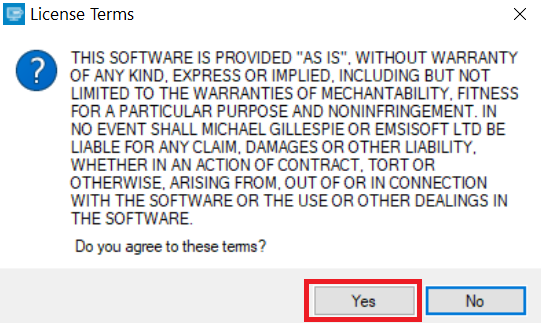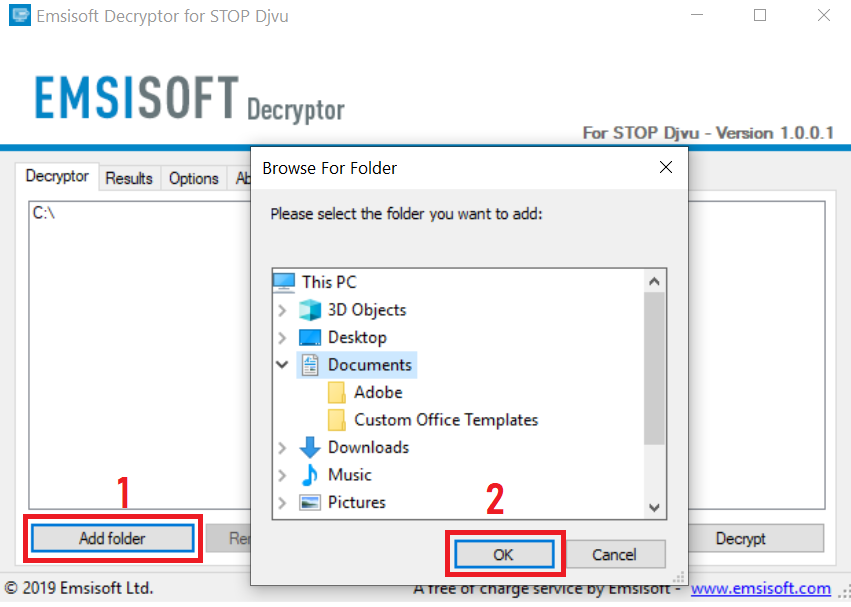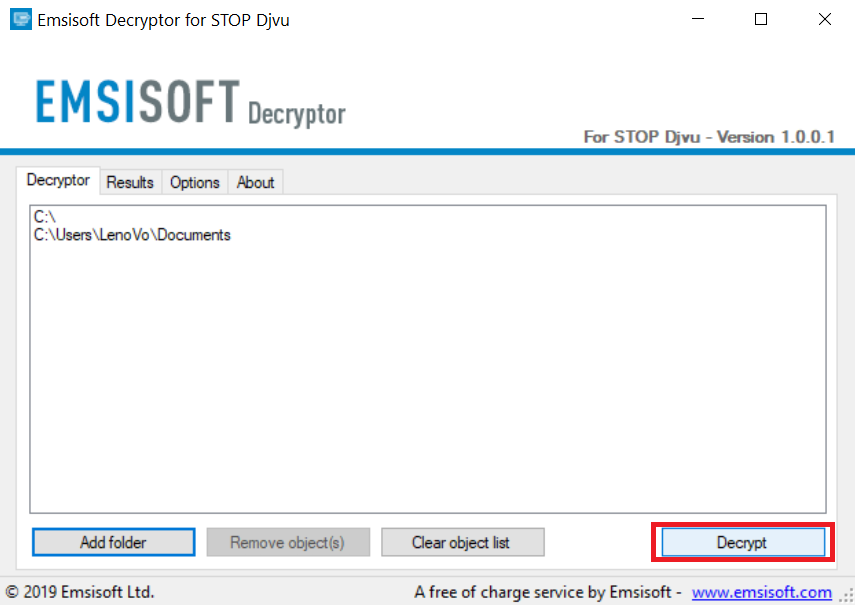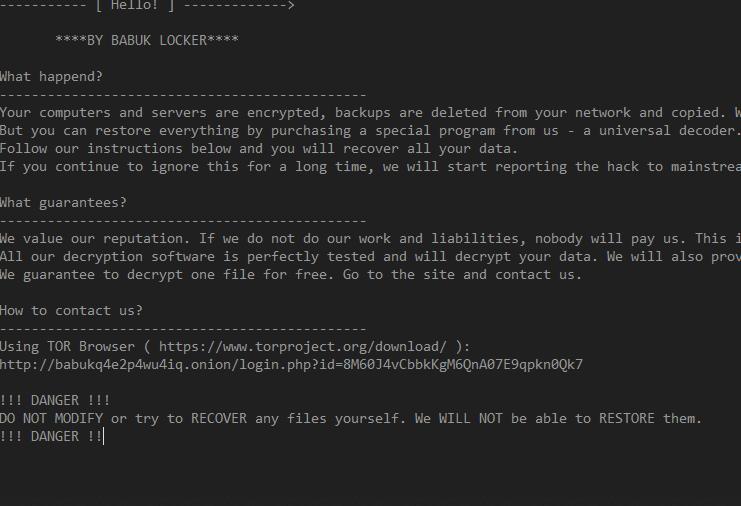._NIST_K571_ file extension is placed on all of your files? ._NIST_K571_ Virus File is also known as Babuk Loader ransomware which locks files on a computer and demands money to be paid as a ransom for unlocking them.
Babuk Loader Ransomware (._NIST_K571_ Virus File)
Babuk Loader or otherwise known as ._NIST_K571_ Virus File is a ransomware type virus. It encrypts files by appending the ._NIST_K571_ extension to them, making them inaccessible. All encrypted files will receive the new extension. The Babuk Loader ransomware drops a ransom note, which gives instructions to victims on how they can allegedly restore their data by paying a ransom fee.
Babuk Loader Ransomware Virus
Babuk Loader Ransomware will encrypt all types of files such as audio, video, pictures, backups, banking data and other personal user files found on a compromised computer system.

._NIST_K571_ Virus Summary
| Name | ._NIST_K571_ Virus |
| File Extension | ._NIST_K571_ |
| Type | Ransomware, Cryptovirus |
| Short Description | The ransomware encrypts files on your computer system and demands a ransom to be paid to allegedly recover them. |
| Symptoms | The Babuk Loader ransomware will encrypt your files by appending the ._NIST_K571_ extension to them. |
| Ransom Demanding Note | How To Restore Your Files.txt |
| Distribution Method | Spam Emails, Email Attachments |
| Detection Tool |
See If Your System Has Been Affected by malware
Download
Malware Removal Tool
|
User Experience | Join Our Forum to Discuss ._NIST_K571_ Virus. |
._NIST_K571_ Virus File – How Did It Infect My PC and What Happened?
The Babuk Loader is a recently discovered ransomware that has been detected in an attack campaign. The origins of this threat are not known, it is supposed to be a new malware family designed by an unknown hacking group. Alternatively, such viruses are ordered through underground hacker communities — their existing families can be modified to create new viruses, or experienced hackers can create new ones for a given price.
At this time it is created mainly for Microsoft Windows machines, and according to the available information it fits as a pretty standard virus of its category. Information about it has been released by the malware researcher Chuong Dong, he gives a detailed view of how this virus works on a given machine. Initial information about it was also found on a hacking forum where an unknown hacking group posts information about a successful malware infection with the Babuk Loader (the ._NIST_K571_ Virus File variant) — the hacking group has infiltrated a healthcare provider and they are blackmailing the victims.
The main mode of infection is not known at the moment, we speculate that it might be one of the following:
- Phishing Methods — The criminals prepare email messages and websites to coerce the victims into interacting with their content. This, in turn, will lead to the virus infection automatically. A common method of doing this is to host the sites on domain names that sound very similar to the ones that are well-known to the victims.
- Virus Carriers — Through the execution of the so-called “virus carriers”, the infection will happen when they are run on the target computers. The two most popular variants are the macro-infected documents which are prepared in all popular formats and the application installers. These setup bundles are popular programs that are commonly downloaded from the Internet. The hackers create them by taking the original setup files from their official sources and adding in the necessary virus code.
- Direct Attacks — The criminals can use a different kind of direct hacking intrusion attacks to go around the security measurements and directly deploy the threat. This is also possible by making use of other malware that will drop this ransomware as part of their execution sequence.
The in-depth virus analysis reveals that the ._NIST_K571_ Virus (Babuk Loader) can be programmed to cause a diverse array of actions on the compromised machines. It can be run on the target machines with command-line parameters that can give extra directions. The default mode will be to encrypt users data on the local machine, however, there is functionality that can also reach files located on network shares and removable storage devices.
Babuk Loader is able to interact with the system services, namely by retrieving the names of the running ones and stopping them at will. By interacting with them the hackers can cause a series of changes — usually, this will result in performance issues, the inability to run certain services, and even information harvesting. The other type of functionality added in this particular virus is the shadow volume copies removal — this will make it very hard to effectively restore the computers without the use of a special data recovery software. It will also disable the internal Windows system restore function.
The collected samples of the ._NIST_K571_ Virus (Babuk Loader) can also interact with the Windows Restart Manager to terminate any processes that might interfere with its function. This effectively creates a way to protect the virus from being tampered with and is regarded as a way to stop security software from protecting the computer from the malware.
With this particular malware release, hackers have implemented different algorithms when dealing with various types of files. This ransomware works with large-size files and smaller ones. Like other similar threats, this one works against commonly used files: documents, multimedia files, archives, backups, and etc. All of the victim data belonging to this release of the Babuk Loader will receive the relevant ._NIST_K571_ extension. In folders where there are affected files, a ransom note will be created in a text document called How To Restore Your Files.txt.
We suspect that attacks with this particular malware will continue in the future and may very well be utilized by different groups. For this reason, detected threats should be removed from the system as soon as possible.

Remove ._NIST_K571_ Virus File
If your computer got infected with the ._NIST_K571_ Virus File, you should have a bit of experience in removing malware. You should get rid of this ransomware as quickly as possible before it can have the chance to spread further and infect other computers. You should remove the ransomware and follow the step-by-step instructions guide provided below.
- Step 1
- Step 2
- Step 3
- Step 4
- Step 5
Step 1: Scan for ._NIST_K571_ Virus with SpyHunter Anti-Malware Tool



Ransomware Automatic Removal - Video Guide
Step 2: Uninstall ._NIST_K571_ Virus and related malware from Windows
Here is a method in few easy steps that should be able to uninstall most programs. No matter if you are using Windows 10, 8, 7, Vista or XP, those steps will get the job done. Dragging the program or its folder to the recycle bin can be a very bad decision. If you do that, bits and pieces of the program are left behind, and that can lead to unstable work of your PC, errors with the file type associations and other unpleasant activities. The proper way to get a program off your computer is to Uninstall it. To do that:


 Follow the instructions above and you will successfully delete most unwanted and malicious programs.
Follow the instructions above and you will successfully delete most unwanted and malicious programs.
Step 3: Clean any registries, created by ._NIST_K571_ Virus on your computer.
The usually targeted registries of Windows machines are the following:
- HKEY_LOCAL_MACHINE\Software\Microsoft\Windows\CurrentVersion\Run
- HKEY_CURRENT_USER\Software\Microsoft\Windows\CurrentVersion\Run
- HKEY_LOCAL_MACHINE\Software\Microsoft\Windows\CurrentVersion\RunOnce
- HKEY_CURRENT_USER\Software\Microsoft\Windows\CurrentVersion\RunOnce
You can access them by opening the Windows registry editor and deleting any values, created by ._NIST_K571_ Virus there. This can happen by following the steps underneath:


 Tip: To find a virus-created value, you can right-click on it and click "Modify" to see which file it is set to run. If this is the virus file location, remove the value.
Tip: To find a virus-created value, you can right-click on it and click "Modify" to see which file it is set to run. If this is the virus file location, remove the value.
Before starting "Step 4", please boot back into Normal mode, in case you are currently in Safe Mode.
This will enable you to install and use SpyHunter 5 successfully.
Step 4: Boot Your PC In Safe Mode to isolate and remove ._NIST_K571_ Virus





Step 5: Try to Restore Files Encrypted by ._NIST_K571_ Virus.
Method 1: Use STOP Decrypter by Emsisoft.
Not all variants of this ransomware can be decrypted for free, but we have added the decryptor used by researchers that is often updated with the variants which become eventually decrypted. You can try and decrypt your files using the instructions below, but if they do not work, then unfortunately your variant of the ransomware virus is not decryptable.
Follow the instructions below to use the Emsisoft decrypter and decrypt your files for free. You can download the Emsisoft decryption tool linked here and then follow the steps provided below:
1 Right-click on the decrypter and click on Run as Administrator as shown below:

2. Agree with the license terms:

3. Click on "Add Folder" and then add the folders where you want files decrypted as shown underneath:

4. Click on "Decrypt" and wait for your files to be decoded.

Note: Credit for the decryptor goes to Emsisoft researchers who have made the breakthrough with this virus.
Method 2: Use data recovery software
Ransomware infections and ._NIST_K571_ Virus aim to encrypt your files using an encryption algorithm which may be very difficult to decrypt. This is why we have suggested a data recovery method that may help you go around direct decryption and try to restore your files. Bear in mind that this method may not be 100% effective but may also help you a little or a lot in different situations.
Simply click on the link and on the website menus on the top, choose Data Recovery - Data Recovery Wizard for Windows or Mac (depending on your OS), and then download and run the tool.
._NIST_K571_ Virus-FAQ
What is ._NIST_K571_ Virus Ransomware?
._NIST_K571_ Virus is a ransomware infection - the malicious software that enters your computer silently and blocks either access to the computer itself or encrypt your files.
Many ransomware viruses use sophisticated encryption algorithms to make your files inaccessible. The goal of ransomware infections is to demand that you pay a ransom payment to get access to your files back.
What Does ._NIST_K571_ Virus Ransomware Do?
Ransomware in general is a malicious software that is designed to block access to your computer or files until a ransom is paid.
Ransomware viruses can also damage your system, corrupt data and delete files, resulting in the permanent loss of important files.
How Does ._NIST_K571_ Virus Infect?
Via several ways.._NIST_K571_ Virus Ransomware infects computers by being sent via phishing emails, containing virus attachment. This attachment is usually masked as an important document, like an invoice, bank document or even a plane ticket and it looks very convincing to users.
Another way you may become a victim of ._NIST_K571_ Virus is if you download a fake installer, crack or patch from a low reputation website or if you click on a virus link. Many users report getting a ransomware infection by downloading torrents.
How to Open .._NIST_K571_ Virus files?
You can't without a decryptor. At this point, the .._NIST_K571_ Virus files are encrypted. You can only open them once they are decrypted using a specific decryption key for the particular algorithm.
What to Do If a Decryptor Does Not Work?
Do not panic, and backup the files. If a decryptor did not decrypt your .._NIST_K571_ Virus files successfully, then do not despair, because this virus is still new.
Can I Restore ".._NIST_K571_ Virus" Files?
Yes, sometimes files can be restored. We have suggested several file recovery methods that could work if you want to restore .._NIST_K571_ Virus files.
These methods are in no way 100% guaranteed that you will be able to get your files back. But if you have a backup, your chances of success are much greater.
How To Get Rid of ._NIST_K571_ Virus Virus?
The safest way and the most efficient one for the removal of this ransomware infection is the use a professional anti-malware program.
It will scan for and locate ._NIST_K571_ Virus ransomware and then remove it without causing any additional harm to your important .._NIST_K571_ Virus files.
Can I Report Ransomware to Authorities?
In case your computer got infected with a ransomware infection, you can report it to the local Police departments. It can help authorities worldwide track and determine the perpetrators behind the virus that has infected your computer.
Below, we have prepared a list with government websites, where you can file a report in case you are a victim of a cybercrime:
Cyber-security authorities, responsible for handling ransomware attack reports in different regions all over the world:
Germany - Offizielles Portal der deutschen Polizei
United States - IC3 Internet Crime Complaint Centre
United Kingdom - Action Fraud Police
France - Ministère de l'Intérieur
Italy - Polizia Di Stato
Spain - Policía Nacional
Netherlands - Politie
Poland - Policja
Portugal - Polícia Judiciária
Greece - Cyber Crime Unit (Hellenic Police)
India - Mumbai Police - CyberCrime Investigation Cell
Australia - Australian High Tech Crime Center
Reports may be responded to in different timeframes, depending on your local authorities.
Can You Stop Ransomware from Encrypting Your Files?
Yes, you can prevent ransomware. The best way to do this is to ensure your computer system is updated with the latest security patches, use a reputable anti-malware program and firewall, backup your important files frequently, and avoid clicking on malicious links or downloading unknown files.
Can ._NIST_K571_ Virus Ransomware Steal Your Data?
Yes, in most cases ransomware will steal your information. It is a form of malware that steals data from a user's computer, encrypts it, and then demands a ransom in order to decrypt it.
In many cases, the malware authors or attackers will threaten to delete the data or publish it online unless the ransom is paid.
Can Ransomware Infect WiFi?
Yes, ransomware can infect WiFi networks, as malicious actors can use it to gain control of the network, steal confidential data, and lock out users. If a ransomware attack is successful, it could lead to a loss of service and/or data, and in some cases, financial losses.
Should I Pay Ransomware?
No, you should not pay ransomware extortionists. Paying them only encourages criminals and does not guarantee that the files or data will be restored. The better approach is to have a secure backup of important data and be vigilant about security in the first place.
What Happens If I Don't Pay Ransom?
If you don't pay the ransom, the hackers may still have access to your computer, data, or files and may continue to threaten to expose or delete them, or even use them to commit cybercrimes. In some cases, they may even continue to demand additional ransom payments.
Can a Ransomware Attack Be Detected?
Yes, ransomware can be detected. Anti-malware software and other advanced security tools can detect ransomware and alert the user when it is present on a machine.
It is important to stay up-to-date on the latest security measures and to keep security software updated to ensure ransomware can be detected and prevented.
Do Ransomware Criminals Get Caught?
Yes, ransomware criminals do get caught. Law enforcement agencies, such as the FBI, Interpol and others have been successful in tracking down and prosecuting ransomware criminals in the US and other countries. As ransomware threats continue to increase, so does the enforcement activity.
About the ._NIST_K571_ Virus Research
The content we publish on SensorsTechForum.com, this ._NIST_K571_ Virus how-to removal guide included, is the outcome of extensive research, hard work and our team’s devotion to help you remove the specific malware and restore your encrypted files.
How did we conduct the research on this ransomware?
Our research is based on an independent investigation. We are in contact with independent security researchers, and as such, we receive daily updates on the latest malware and ransomware definitions.
Furthermore, the research behind the ._NIST_K571_ Virus ransomware threat is backed with VirusTotal and the NoMoreRansom project.
To better understand the ransomware threat, please refer to the following articles which provide knowledgeable details.
As a site that has been dedicated to providing free removal instructions for ransomware and malware since 2014, SensorsTechForum’s recommendation is to only pay attention to trustworthy sources.
How to recognize trustworthy sources:
- Always check "About Us" web page.
- Profile of the content creator.
- Make sure that real people are behind the site and not fake names and profiles.
- Verify Facebook, LinkedIn and Twitter personal profiles.














